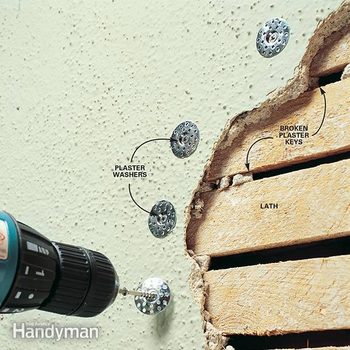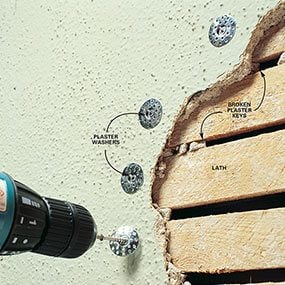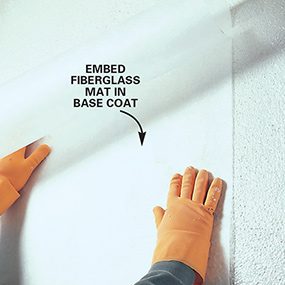How To Repair Water Damaged Wall Plaster
How to Repair Plaster
Updated: Dec. 04, 2022
Quick fixes for cracked plaster

Repair sagging, cracking plaster walls and avoid the mess of demolition. With plaster washers and wide fiberglass mesh, old plaster walls tin be made smooth and solid again.
You might also like: TBD
Saving loose plaster
Plaster sags from ceilings or bulges from walls when the plaster keys embedded effectually the wood board intermission loose. To repair it, you lot've got two choices. You tin break out all the loose stuff and replaster the expanse—non a do-it-yourself project. Or, you tin can stabilize the sagging plaster by using plaster washers to pull it back up against the board. Plaster washers don't always work, just they're cheap and so it's worth a shot.
First, locate the joists or studs and mark their location in the loose area. Button up the loose plaster and place 2-in. screws and the perforated plaster washers into the joists or studs about every 6 or 8 in. The convex washer will flatten as the screw tightens. If the plaster has a rough surface, you may demand to first scrape the surface to get the washer to lie flat. Next, secure the loosened field to the lath betwixt joists with more washers. Finally, skim-coat over the washers with drywall joint compound. It may take several coats and actress effort to create a smooth end or mimic the existing texture.
If you take solidly attached plaster with cracks spider-webbing through your walls and ceilings, you tin can stabilize and glaze the entire surface with another product—broad sheets of fiberglass mat. Self-stick mats are available at home centers. But stick them to the wall or ceiling and then skim coat with two or three coats of joint chemical compound. Another system, called Nu-Wal, uses a slightly unlike method. First, y'all roll on a latex-like base of operations coat. And then embed the fiberglass mesh, and coil over it again. This method substantially gives your plaster walls a new flexible skin so non-structural cracks won't reappear. Plus, information technology acts similar a vapor barrier, keeping moisture from migrating into the wall, and it'due south approved for lead paint encapsulation on interior walls.
Demand to Remove Plaster and Lathe?
Required Tools for this Project
Accept the necessary tools for this DIY project lined up before you start—y'all'll save time and frustration.
Required Materials for this Project
Avert last-minute shopping trips by having all your materials set ahead of time. Here's a list.
Originally Published: December 04, 2022
Source: https://www.familyhandyman.com/project/how-to-repair-plaster/




0 Response to "How To Repair Water Damaged Wall Plaster"
Post a Comment